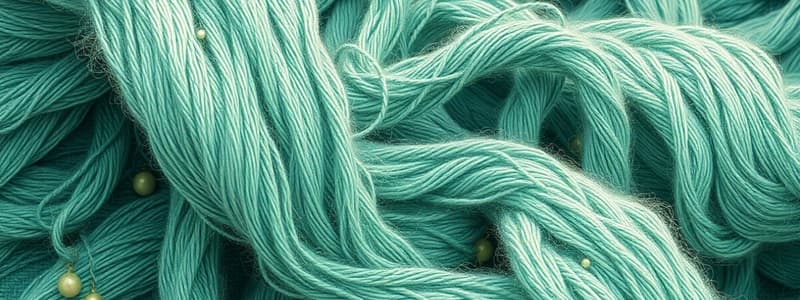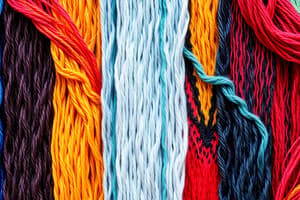Podcast
Questions and Answers
A garment is labeled as having a blend of cotton and polyester. According to labeling requirements, what information MUST also be included?
A garment is labeled as having a blend of cotton and polyester. According to labeling requirements, what information MUST also be included?
- Recommended styling tips and coordinating accessories.
- The garment's thread count and weaving technique.
- The price of the garment and the retailer's return policy.
- The percentage of each fiber, the manufacturer's identification, and the country of origin. (correct)
Which characteristic distinguishes filament yarns from spun yarns?
Which characteristic distinguishes filament yarns from spun yarns?
- Filament yarns are made from short, staple fibers, creating a fuzzy surface.
- Filament yarns are created by twisting long, continuous strands, resulting in a smooth, lustrous surface. (correct)
- Filament yarns are exclusively used in heavy-duty industrial applications.
- Filament yarns are typically less strong and durable than spun yarns.
In what scenario would calculating the cost per wear be MOST beneficial?
In what scenario would calculating the cost per wear be MOST beneficial?
- Comparing the environmental impact of different fabrics.
- Estimating the production costs of a garment.
- Determining the resale value of a used garment.
- Assessing the long-term value of a higher-priced item versus a lower-priced alternative. (correct)
Why is wool known for its resiliency, allowing it to bounce back into shape after being stretched?
Why is wool known for its resiliency, allowing it to bounce back into shape after being stretched?
Given your knowledge of fabric properties, which fabric would be most appropriate for athletic wear designed to keep the wearer dry during intense exercise?
Given your knowledge of fabric properties, which fabric would be most appropriate for athletic wear designed to keep the wearer dry during intense exercise?
Why might a U.S. apparel company struggle to compete with manufacturers in other countries?
Why might a U.S. apparel company struggle to compete with manufacturers in other countries?
Which garment care instruction would be LEAST likely to appear on a clothing label?
Which garment care instruction would be LEAST likely to appear on a clothing label?
Under the Textile Fiber Products Identification Act, what information about a textile product MUST be included on its label?
Under the Textile Fiber Products Identification Act, what information about a textile product MUST be included on its label?
Why is raising the sewing machine needle to its highest position recommended when not in use?
Why is raising the sewing machine needle to its highest position recommended when not in use?
Why is cotton considered an ideal fabric for clothing worn in hot, humid conditions?
Why is cotton considered an ideal fabric for clothing worn in hot, humid conditions?
What is 'fabric pilling,' and why does it occur?
What is 'fabric pilling,' and why does it occur?
How does combing fibers contribute to the quality of a textile?
How does combing fibers contribute to the quality of a textile?
If a person spills red wine on their cashmere sweater, what type of solution would be recommended to remove the stain, based on the provided care tips?
If a person spills red wine on their cashmere sweater, what type of solution would be recommended to remove the stain, based on the provided care tips?
You are designing a line of apparel. Considering the qualities associated with different fabric orientations, why might a designer choose to cut a garment 'on the bias'?
You are designing a line of apparel. Considering the qualities associated with different fabric orientations, why might a designer choose to cut a garment 'on the bias'?
A recent graduate wants to become a retail buyer in the textile industry. What level of education is typically required for this role?
A recent graduate wants to become a retail buyer in the textile industry. What level of education is typically required for this role?
Flashcards
Natural Fibers
Natural Fibers
Fibers derived from animal or vegetable sources.
Manufactured Fibers
Manufactured Fibers
Fibers created through processing raw materials or chemicals.
Filament Yarns
Filament Yarns
Yarns made by twisting several strands of fiber, creating a smooth surface.
Spun Yarns
Spun Yarns
Signup and view all the flashcards
Ready-to-Wear Garments
Ready-to-Wear Garments
Signup and view all the flashcards
Couture
Couture
Signup and view all the flashcards
Cost Per Wear Formula
Cost Per Wear Formula
Signup and view all the flashcards
Resiliency
Resiliency
Signup and view all the flashcards
Fabric Pilling
Fabric Pilling
Signup and view all the flashcards
Textile Fiber Products Identification Act
Textile Fiber Products Identification Act
Signup and view all the flashcards
Wicking Fabric
Wicking Fabric
Signup and view all the flashcards
Bias
Bias
Signup and view all the flashcards
Sewing machine needle
Sewing machine needle
Signup and view all the flashcards
Combing the fibers
Combing the fibers
Signup and view all the flashcards
Wool's resiliency
Wool's resiliency
Signup and view all the flashcards
Study Notes
Textile and Fiber Types
- Natural fibers are classified as either animal (wool, silk) or vegetable (cotton, linen).
- Manufactured fibers are created by processing raw materials or chemicals.
- Cellulosic manufactured fibers include rayon, triacetate, and acetate.
- Non-cellulosic manufactured fibers include over 20 synthetic fibers with generic names.
- Filament yarns are made by twisting several fiber strands, creating smooth, lustrous fabric surfaces.
- Spun yarns are made by twisting many short fibers and result in fuzzy surfaces.
- Single-ply yarns are the most common type used in fabric production.
Fashion and Textile Fundamentals
- Ready-to-wear garments are mass-produced and sold "off the rack" for the general market.
- Garment labels must include fiber content, country of origin, producer identification number, and care instructions.
- The Care Labeling Act was established in 1972.
- Couture refers to custom-designed and manufactured garments tailored to a client's specs.
- Cost Per Wear is calculated as Original Price ÷ Number of Times Worn.
- A $50 coat worn 200 times offers better cost-per-use value.
Fabric and Textile Information
- Worsted wool is a fine, strong wool used in high-quality fabrics such as suits.
- Black satin is effective for blocking sunlight.
Cleaning and Care
- An alkaline solution can help remove red stains from cashmere.
- Fabric resiliency is the ability to spring back into shape after stretching.
- Combing the fibers makes material softer.
- Wool's resiliency comes from natural cross-links and crimps.
Apparel Sizing
- Apparel sizing is relatively similar across U.S. companies, though minor differences exist.
- Labels may provide care instructions, but they do not focus on cost-effectiveness.
- The type of finish on a material and factors such as the surface type and stain source, determine the type of care for an item.
Textile Industry
- A bachelor's degree is typically needed to become a retail buyer in the textile industry.
- Raise the sewing machine lever and needle to the highest position to prevent snagging and bending.
- Ideal fabric to wear in high humidity and temperatures in the upper 90s is cotton, as it is breathable and absorbs moisture well.
- Fabric pilling is fuzzy fibers which ball up, adhering to the surface, often after washing.
- A disadvantage of the U.S. apparel industry is higher labor costs than countries with cheaper production.
- Wicking fabric is used in athletic wear to draw moisture away from the skin.
- Bias is the diagonal direction of woven fabric with the greatest stretch.
- Carded fabric consists of short, thick cotton fibers.
- Wool pants are the most resistant to wrinkles.
- The Textile Fiber Products Identification Act requires labels to include fiber content, manufacturer RN number, and country of origin.
Studying That Suits You
Use AI to generate personalized quizzes and flashcards to suit your learning preferences.




